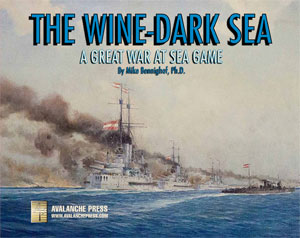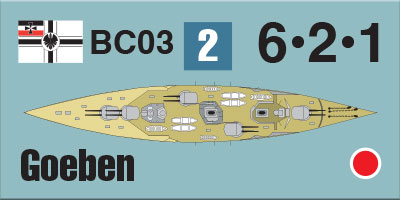| The Wine-Dark Sea:
History & Scenarios, Part One
By Mike Bennighof, Ph.D.
October 2023
 A very long time ago, I designed a game about naval action on the Black Sea in World War One. That wasn’t a very marketable topic, so I expanded on the idea with a new game about naval action on the Mediterranean Sea during World War One. That topic wasn’t any more marketable, but people bought a lot of copies anyway. A very long time ago, I designed a game about naval action on the Black Sea in World War One. That wasn’t a very marketable topic, so I expanded on the idea with a new game about naval action on the Mediterranean Sea during World War One. That topic wasn’t any more marketable, but people bought a lot of copies anyway.
And now we’re about to release Great War at Sea: The Wine-Dark Sea (formerly titled Mediterranean Ultimate Edition), a new game on that same topic. Not many people know there even was a naval campaign on the Mediterranean Sea in World War One, but thanks to Barbara Tuchman at least a few have heard of the British pursuit of the German battle cruiser Goeben. It’s the centerpiece of the game, so much so that I toyed with naming it SMS Goeben: An Enemy Then Flying (Tuchman’s chapter title), but realized that salespeople would never be able to pronounce it (thereby violating our Tammy Rule).
In our more recent naval games (the second editions of Eastern Fleet, Bismarck, and Jutland) we took larger or more well-known operations and, in addition to the longer scenario covering the complete operation, broke them down into separate scenarios that picked up the action at key moments. That’s the approach the new game takes with the cruise of the Goeben.

Great War at Sea, like its sister series Second World War at Sea, has two types of scenarios. Operational scenarios take place on the operational map (the one of the Mediterranean Sea) and players move their fleets across it. Battle scenarios take place just on the Tactical Map, and players fight there with their ships (similarly to what happens when fleets meet on the operational map, but skipping ahead to the fighting part).
Our more recent games and books in both series weave those two types of scenarios together to tell the story of the campaign. Showing the battles that took place, or could have taken place, as a result of the operations brings the admirals’ decisions into sharper focus. So each operational scenario is accompanied by a battle scenario, and often several of them. And that’s how we tell Goeben’s story.
The Imperial Germany Navy had assigned the modern battle cruiser Goeben and light cruiser Breslau to the Mediterranean in 1912 to show the flag during the Balkan Wars. Afterwards they had become Germany’s contribution to the joint German-Austrian-Italian Triple Alliance war plan, to serve under Austrian command in case of war.

When war actually approached in late July 1914, the Germans promptly forgot the details of the Triple Alliance war plan, while the Italians forgot the alliance completely. Goeben had always been a troublesome ship (not coincidentally, her builders Blohm & Voss held a monopoly on German battle cruiser construction), and the war warnings found her in Pola’s Austrian naval dockyard receiving new tubes for her boilers.
Quickly wrapping up the work and heading for the Italian port of Messina, Rear Admiral Wilhelm Souchon found his ostensible allies unwilling to provide coal for his ships, much less send their own cruisers to join him on a raid against French troop transports as the war plan directed. Souchon steamed west on his own, only to be ordered to Constantinople. After a pointless bombardment of an Algerian port, he complied and returned to Messina, where the Italians slow-walked his attempts to re-fuel.
With only a partial load of coal, Souchon headed for Turkey, encountering a squadron of British armored cruisers off the Greek coast, who declined to engage. Refueling from a collier in a Greek cove, he brought his ships to the Turkish capital amid great public acclaim and embarrassment to the Royal Navy.

Goeben’s cruise did not guarantee Turkey’s entry into the war, which took place two months later. Not did it “change the world” as Dan van der Vat’s lathered-up book title would have it. And she might have been of more use in the Adriatic after all. But she did open the Great War at Sea on a dramatic note, one worthy of study-by-scenario.
We included Goeben’s flight in our old Great War at Sea: Mediterranean game, with a single operational scenario and three battle scenarios. They were actually pretty good, and had I organized them together they would have gone a long way toward building a campaign narrative. But in those days, I hadn’t yet seen how to do that. The game had a lot of scenarios, but I didn’t try to tell a story with them.
The Goeben scenario in the old Mediterranean is loaded with optional rules, both to create some of the uncertainty for the Allied player that the historical actors faced, and to weave in some of the many events that almost took place, but did not. I’ve since realized that players won’t really try out the scenario’s options individually, or the core historical scenario – they want to take every option and every ship, and fight it out with all of them.

So for The Wine Dark Sea, I’ve taken the same approach as with recent Second World War at Sea games. We have a full-length Goeben scenario, but as in the old game it’s not likely to produce the same cruise as Souchon took – both players simply have too many choices that might go in a different direction.
Other scenarios pick up the action later on: when the German cruisers lay off the Algerian coast, and might have tried to run for the Atlantic (this is tougher in The Wine Dark Sea, as the narrow Strait of Gibraltar is on the map) or attacked the French troop convoys running from Algeria to France. There’s another that starts after Goeben has returned to Messina, with the British waiting outside Italian waters. And then one with Goeben in Greek waters, running for Constantinople but short of coal and trailed by the British.
Each of those is, of course, supported by one or more battle scenarios. Goeben did not actually engage any of her enemies in combat during this cruiser, but only because war had not yet been declared when she met a pair of British battle cruisers, and because the squadron of British armored cruisers declined to fight her. Showing, rather than telling, how surface battle might have unfolded helps illustrate the action in a way that a textual narrative can’t.

And then there are the alternative scenarios. Adding them as options to the core scenario is kind of awkward; that’s the way we’ve done it for decades and it’s always been sort of awkward. So we look at some of the other possibilities in their own scenarios, with their own victory conditions: the intervention of the Austrian fleet outside the Adriatic Sea, Italian participation in the Triple Alliance as planned, deployment of British battleships to the Mediterranean, and so on. Each of those with battle scenarios as well, of course.
The Goeben chapter is only part of The Wine-Dark Sea, with easily enough story and enough play to stand alone as its own game. Next time we’ll look at another chapter.
Click here to join the Gold Club
See your Gold Club Insider newsletter for ordering information.
Sign up for our newsletter right here. Your info will never be sold or transferred; we'll just use it to update you on new games and new offers.
Mike Bennighof is president of Avalanche Press and holds a doctorate in history from Emory University. A Fulbright Scholar and NASA Journalist in Space finalist, he has published a great many books, games and articles on historical subjects; people are saying that some of them are actually good.
He lives in Birmingham, Alabama with his wife and three children. He will never forget his Iron Dog, Leopold. Leopold needed no revisions.
Want to keep Daily Content free of third-party ads? You can send us some love (and cash) through this link right here.
|
